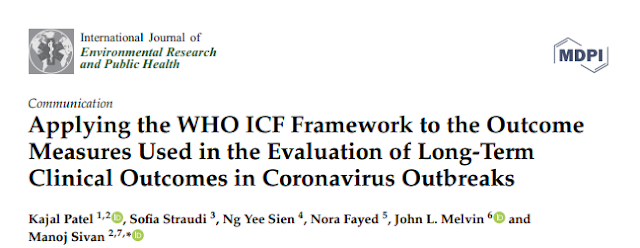Applying the WHO ICF Framework to the Outcome Measures Used in the Evaluation of Long-Term Clinical Outcomes in Coronavirus Outbreaks
ABSTRACT
(1) Objective: The World Health Organization’s (WHO) International Classification of Functioning, Disability and Health (ICF) classification is a unified framework for the description of health and health-related states. This study aimed to use the ICF framework to classify outcome measures used in follow-up studies of coronavirus outbreaks and make recommendations for future studies. (2) Methods: EMBASE, MEDLINE, CINAHL and PsycINFO were systematically searched for original studies assessing clinical outcomes in adult survivors of severe acute respiratory distress syndrome (SARS), middle east respiratory syndrome (MERS) and coronavirus disease-19 (COVID-19) after hospital discharge. Individual items of the identified outcome measures were linked to ICF second-level and third-level categories using ICF linking rules and categorized according to an ICF component. (3) Results: In total, 33 outcome measures were identified from 36 studies. Commonly used (a) ICF body function measures were Pulmonary Function Tests (PFT), Impact of event scale (IES-R) and Hospital Anxiety and Depression Scale (HADS); (b) ICF activity was 6-Minute Walking Distance (6MWD); (c) ICF participation measures included Short Form-36 (SF-36) and St George’s Respiratory Questionnaire (SGRQ). ICF environmental factors and personal factors were rarely measured. (4) Conclusions. We recommend future COVID-19 follow-up studies to use the ICF framework to select a combination of outcome measures that capture all the components for a better understanding of the impact on survivors and planning interventions to maximize functional return.
DOWNLOAD DO ARTIGO
https://www.mdpi.com/1660-4601/17/18/6476
REFERÊNCIAS
PATEL, K. et al. Applying the who ICF framework to the outcome measures used in the evaluation of long-term clinical outcomes in coronavirus outbreaks. International Journal of Environmental Research and Public Health, v. 17, n. 18, p. 1–15, 2020.

Comentários
Postar um comentário